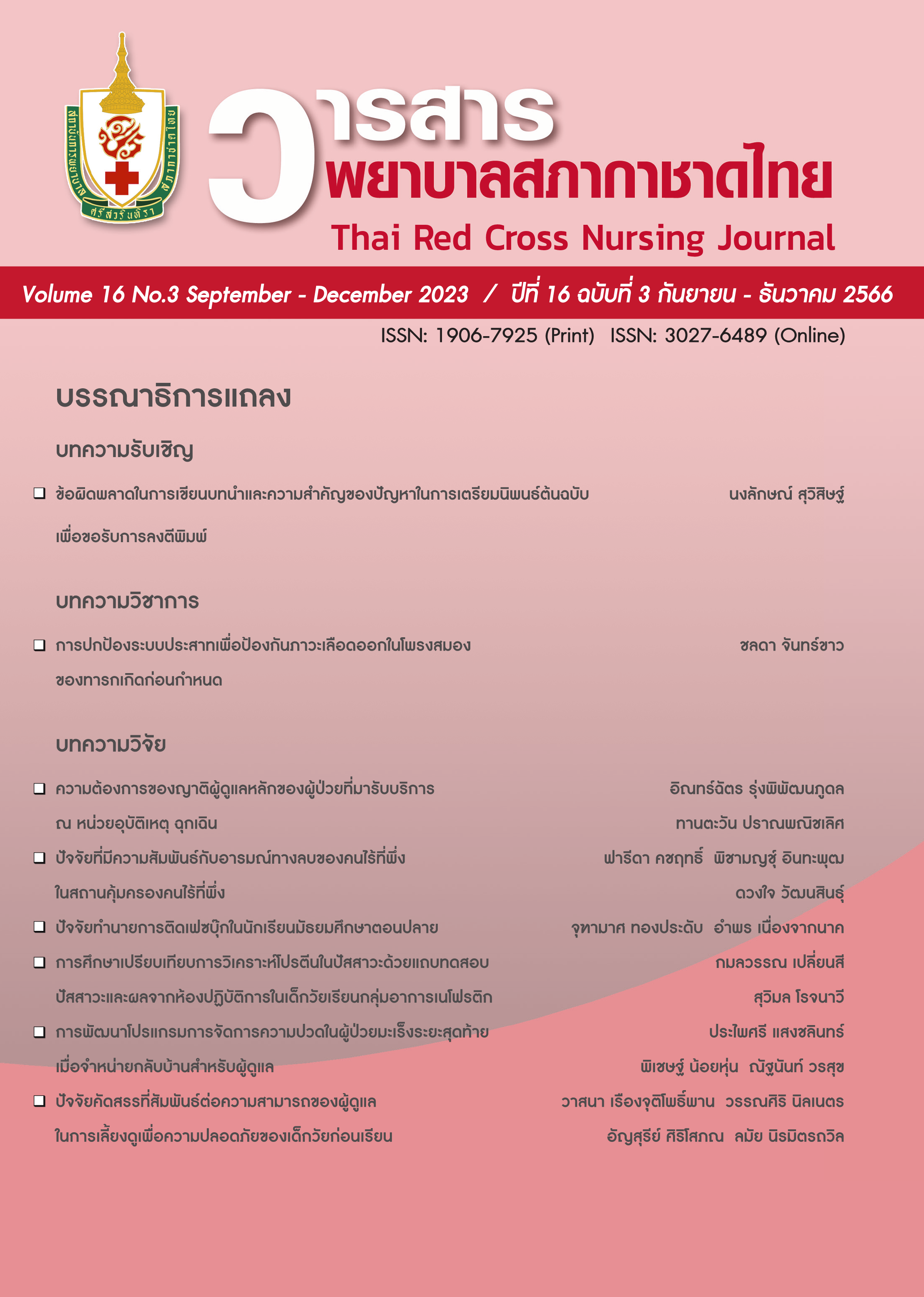A Comparative Study of Urine Protein Analysis Using Urine Dipstick Testing and Laboratory Results in School-Age Children with Nephrotic Syndrome
Keywords:
proteinuria, school-age children, nephrotic syndromeAbstract
The objective of this study was to compare the differences in urine protein when testing with a urine dipstick with results obtained in a hospital laboratory. The sample group consisted of school-age children diagnosed with nephrotic syndrome for at least 3 months at the outpatient department of a university hospital, the Thai Red Cross. A total of 65 willing and cooperative participants, including parents and school-age patients, were involved in the investigation. The research tools included a demographic data questionnaire and urine dipstick testing. Data were analyzed using descriptive statistics and chi-square test. The research findings indicated no statistically significant difference between the results of urine protein testing with the dipstick and those from the hospital laboratory (X2=188.28, p-value<0.01).
The study reflects the efficiency of a urine dipstick in analyzing urine protein among school-age children with nephrotic syndrome. Nurses and parents can employ this technique for monitoring urine protein and observing recurrent symptoms in this patient group. This method is rapid, convenient, economical, and can contribute to decreasing the waiting time for laboratory results, thereby contributing to the advancement of pediatric patient care through telemedicine.
References
Somkanya T and Worawan C. Summary of update in Thai clinical practice recommendations for CKD [Internet]. 2022 [cited 2023 Jan 24]. Available from: https://cimjournal.com/confer-update/update-ckd-2022/ (in Thai)
Andolino TP, Reid-Adam J. Nephrotic syndrome. Pediatr Rev 2015;36(3):117-28.
Information Technology Department Chulalongkorn Hospital, Thai Red Cross Society. Annual statistical report 2022. Bangkok: Hospital; 2023. (in Thai)
Wang CS, Troost JP, Greenbaum LA, Srivastava T, Reidy K, Gibson K, et al. Text messaging for disease monitoring in childhood nephrotic syndrome. Kidney Int Rep 2019;4(8):1066-74.
Murugan R. Comprehensive paediatric nursing. 2nd ed. New Delhi, India: Laxmi Publications; 2017.
Ambarsari CG, Utami DAP, Tandri CC, Satari HI. Comparison of three spot proteinuria measurements for pediatric nephrotic syndrome: based on the International pediatric Nephrology Association 2022 Guidelines. Ren Fail 2023;45(2):2253324. doi: 10.1080/0886022X.2023.2253324.
Muradova G, Yürük Yildirim Z, Türkkan ÖN, Nayir A. Results of urine dipstick screening test in elementary school children. Ist Tıp Fak Derg 2020;83(3):254-8.
Singh AS, Masuku MB. Sampling techniques & determination of sample size in applied statistics research: an overview. International Journal of Economics, Commerce and Management 2014;2(11):1-22.
Boonrat V, Yuddthakran Y, Kotchakorn I. Urine sample preparation for laboratory proficiency testing of pregnancy test by strip and protein-sugar test by 2 parameters strips. The 23rd Department of Medical Sciences Academic Conference; 2015. (in Thai)
Department of Health, Ministry of Public Health. Weight for height [Internet]. 2021 [cited 2023 Dec 26]. Available from: https://nutrition2.anamai.moph.go.th/th/kidgraph (in Thai)
Hogg RJ, Portman RJ, Milliner D, Lemley KV, Eddy A, Ingelfinger J. Evaluation and management of proteinuria and nephrotic syndrome in children: recommendations from a pediatric nephrology panel established at the National Kidney Foundation conference on proteinuria, albuminuria, risk, assessment, detection, and elimination (PARADE). Pediatrics 2000;105(6):1242-9.
Sultana MN, Majumder B, Rahman MJ, Moniruzzaman AM, Suja AM, Ali ME, et al. Dipstick method versus spot urinary protein creatinine ratio for evaluation of massive proteinuria in childhood nephrotic syndrome. Mymensingh Med J 2018;27(2):369-74.
Lim D, Lee D-Y, Cho SH, Kim OZ, Cho SW, An SK, et al. Diagnostic accuracy of urine dipstick for proteinuria in older outpatients. Kidney Res Clin Pract 2014;33(4):199-203.
Teeuw HM, Amoakoh HB, Ellis CA, Lindsley K, Browne JL. Diagnostic accuracy of urine dipstick tests for proteinuria in pregnant women suspected of preeclampsia: a systematic review and meta-analysis. Pregnancy Hypertension 2022;27:123-30.
Somanathan N, Farrell T, Galimberti A. A comparison between 24-hour and 2-hour urine collection for the determination of proteinuria. J Obstet Gynaecol 2003;23(4):378-80.
Tormo C, Lumbreras B, Santos A, Romero L, Conca M. Strategies for improving the collection of 24-hour urine for analysis in the clinical laboratory: redesigned instructions, opinion surveys, and application of reference change value to micturition. Arch Pathol Lab Med 2009;133(12):1954-60.
Wang CS, Boyd R, Mitchell R, Wright WD, McCracken C, Escoffery C, Patzer RE, Greenbaum LA. Development of a novel mobile application to detect urine protein for nephrotic syndrome disease monitoring. BMC Med Inform Decis Mak 2019;19(1):105. doi: 10.1186/s12911-019-0822-z.
Downloads
Published
Issue
Section
License
Copyright (c) 2024 Srisavarindhira Thai Red Cross Institute of Nursing

This work is licensed under a Creative Commons Attribution-NonCommercial-NoDerivatives 4.0 International License.
เนื้อหาบทความหรือข้อคิดเห็นต่างๆ ในวารสารพยาบาลสภากาชาดไทยนี้ เป็นความคิดเห็นของผู้เขียนบทความ ไม่ใช่ความเห็นของกองบรรณาธิการ หรือสถาบันการพยาบาลศรีสวรินทิรา สภากาชาดไทย






